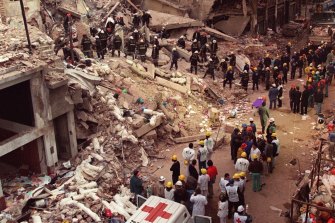Tel Aviv: Two terrorist attacks on Israeli and Jewish targets in Buenos Aires, Argentina, in the 1990s that killed scores of people were carried out by a secret Hezbollah unit whose operatives, contrary to widespread claims, were not abetted knowingly by Argentinian citizens nor aided by Iran on the ground, according to an investigation by the Mossad, Israel’s secret service.
The internal Mossad study, the written findings of which were shared with The New York Times, provide a detailed account of how the attacks were planned — including how material for the explosives was smuggled into Argentina in shampoo bottles and chocolate boxes.
Firefighters and rescue workers search through the rubble of the Buenos Aires Jewish Community centre after a car bomb destroyed the building, killing 85 people in 1994.Credit:AP/File
While Mossad stresses that Israeli intelligence still believes that Iran, a supporter of Hezbollah, approved and funded the attacks and supplied training and equipment, the findings counter long-standing assertions by Israel, Argentina and the United States that Iran had an operational role on the ground. They also countered suspicions in Argentina that local officials and citizens there had been complicit.
In the first attack, which killed 29 people in 1992, the Israeli embassy was blown up. The second, in 1994, targeted the headquarters of a Jewish community centre, killing 86 people, including the bomber.
The bombings were carried out by Hezbollah in revenge for Israeli operations against the Shiite militia in Lebanon, according to the Mossad investigation.
The attackers were not brought to justice or killed in multiple assaults by Israel on Hezbollah over the years and are living in Lebanon, the investigation reported.
Interpol “red notices” have been issued against two people accused of being attackers, both identified in the Mossad investigation as Lebanese Hezbollah operatives. A third person is wanted by the United States. Hezbollah’s operations commander, Imad Mughniyeh, who was mentioned by the Mossad investigation as the chief of the unit that carried out the attacks, was killed in a joint Israeli and US operation in 2008.
The Mossad conclusions are based on information from agents, from the questioning of suspects, and from surveillance and wiretapping. The findings from the internal reports were confirmed in interviews this month with five current and former senior Mossad officials.
The investigation also revealed failures by Mossad, which had no advance warning of the attacks. The second was similar to the first and was carried out by the same group, but the investigation showed that Israeli intelligence had not detected any activity preceding it.
The Mossad inquiry and the current and former officials said that Hezbollah, outgunned by the Israeli army in Lebanon in a conventional sense, began building covert units around the world to expand its reach and attack Israelis or Jewish targets.
Starting in 1988, Hezbollah sent operatives to several South American countries to acquire “experience to enable them to open legitimate businesses and have strong commercial cover for moving around between different countries,” according to the Mossad findings.
The investigation identifies operatives by name and details forged passports and other documents used. The operatives gathered intelligence about border security, about setting up cover companies and about possible targets, including the Israeli Embassy in Buenos Aires.
This article originally appeared in The New York Times.
Most Viewed in World
From our partners
Source: Read Full Article
-
Allies say Rishi Sunak should stay as Tory leader after narrow loss
-
Restaurants open late in Denver past midnight
-
‘Somebody’s dying tonight’: Accused killer penned rap about murder
-
Mark Zuckerberg earns blue belt in Jiu Jitsu after accepting Musk’s cage fight
-
Closure of UK gender clinic does not mean change needed in Australia

